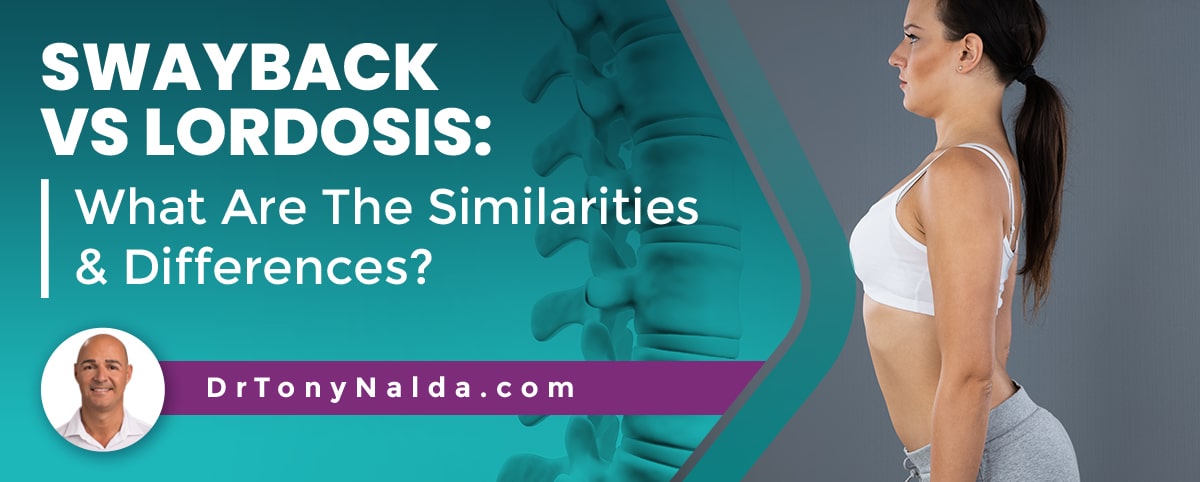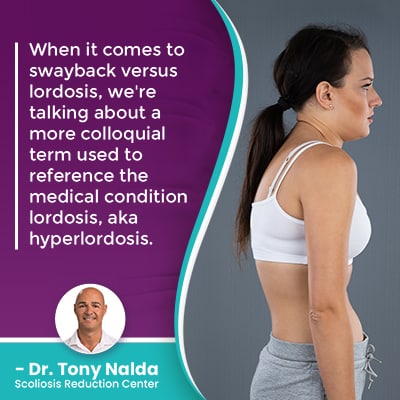Swayback vs Lordosis: What Are The Similarities & Differences?

The spine's natural and healthy curves make it strong, flexible, and able to evenly absorb and distribute mechanical stress, so when the spine loses one or more of its healthy curves, problems occur. There are two main spinal curvature types: lordosis and kyphosis. Continue reading to understand the difference.
Lordosis involves the development of an excessive lordotic curve and refers to the spine's inward curves that bend towards the body's center; swayback refers to the appearance a loss of lumbar lordosis causes and is used interchangeably with lordosis and/or hyperlordosis to reference the condition.
To better understand the importance of the spine's healthy curves and alignment, let's start with some basic spinal anatomy.
Table of Contents
Anatomy of a Healthy Spine
The spine has three main sections, and each has a characteristic curvature type: the cervical spine (neck), thoracic spine (middle/upper back), and the lumbar spine (lower back).
The cervical and lumbar spinal sections feature lordotic curves, meaning the spine bends inwards in a standard 'C' shape, and the thoracic spine has the curvature type known as kyphosis, that bends outwards, away from the body's center in a reverse 'C' shape.
The spine is made up of vertebrae (bones of the spine) that are stacked on top of one another, and when the spine's natural and healthy curves are in place, its vertebrae are aligned in a straight and neutral position as they should be.
The vertebral bodies are separated by intervertebral discs, and these discs play many important roles in maintaining spinal strength, health, and function.
As a disc sits between adjacent vertebrae, they provide the spine with structure (the vertebrae attach to the disc in between) and cushioning so friction isn't generated during movement; when bones rub up against each other, it can erode cartilage, cause uneven wear and tear, and excessive rates of spinal degeneration.
The discs also combine forces to facilitate flexible movement and act as the spine's shock absorbers.
It's because of the many important roles of the discs that they are commonly the first spinal structures to start to deteriorate.
So now that we have a basic understanding of healthy spinal anatomy, let's address the specifics of lordosis and swayback posture.
What is Lordosis?
As mentioned, the spine's natural lordosis can be found in the cervical spine and the lumbar spine.
Now, not everyone is going to have the exact same size of lordotic curve, and as long as a person's curvature degree falls within a normal range, the curve is healthy, but if it becomes under-pronounced or excessive and falls beyond a normal range, this becomes problematic.
Each spinal curve is dependent upon the health of the others, so if one natural spinal curve is lost, the spine responds by putting in bad curves, and this disrupts the biomechanics of the entire spine.
A healthy range of cervical lordosis would fall between 20 and 40 degrees, and a normal range of lumbar lordosis would fall within a range of 40 to 60 degrees.
So if the cervical spine has a lordotic curve that measures less than 20 degrees, this is considered hypolordotic, and if it measures over 40 degrees, this is diagnosed as hyperlordotic (hyperlordosis).
A measurement of less than 20 degrees in the cervical spine is deemed ‘hypolordotic’, while curves that are larger than 40 degrees are considered ‘hyperlordotic’.
 When it comes to swayback versus lordosis, we're talking about a more colloquial term used to reference the medical condition lordosis, aka hyperlordosis.
When it comes to swayback versus lordosis, we're talking about a more colloquial term used to reference the medical condition lordosis, aka hyperlordosis.
Lordosis can affect both the cervical and lumbar spinal sections, but it is more common in the lumbar spine, and this is understood as a result of the lower back's responsibilities.
Each spinal section is important and has its own roles to play in spinal health and function, but the lumbar spine has the added responsibility of supporting the weight of the trunk, the spinal sections above, and it also feels the effects of bending, twisting, and lifting; this is why it's said that everyone will experience issues with lower back pain at some point in their lives.
Swayback posture is what hyperlordosis of the lumbar spine causes: the abdomen, hips and pelvis protrude forward excessively, while the buttocks projects backwards excessively, causing a swayback posture and appearance, which is why many people refer to lordosis of the lumbar spine simply as swayback.
If a patient's cervical lordosis is lost, meaning the neck becomes excessively straight, the neck is pushed forward more than it should be, and the cervical spine is the bridge between the brain, the spine, and the rest of the body; in addition, the neck has to support the weight of the head.
When the neck shifts forward as little as an inch, it's thought that the weight of the head on the neck increases by approximately 10 pounds by the postural deviation.
Lordosis Symptoms
No two lordosis cases will be the same, which is why treatment plans need to be fully customized to address important patient/condition variables.
Patient age and overall health, condition severity, experienced symptoms, and a condition's underlying cause all shape the design of effective treatment plans.
As mentioned, unhealthy degrees of lordosis can affect the cervical and lumbar spinal sections, and common symptoms associated with cervical lordosis can include:
- A weaker cervical spine that's more prone to injury
- A loss in spinal flexibility and range of motion
- Muscle spasms, tension, and pain
- Tension headaches
- Sore shoulders
- Disc degeneration and weakness
- Postural changes that disrupt the body's overall symmetry
If the lumbar spine loses its natural and healthy range of lordosis, these are some common symptoms:
- Swayback posture
- The inability to lie flat on the floor with the entire spine in contact with the surface below
- Back pain
- Neck pain (compensatory curve)
- Pain that radiates into the legs and feet due to nerve compression
- Sensations of tingling and/or numbness
In some cases of mild lumbar lordosis, the only noticeable symptom is the postural change caused by the exaggerated inward curve of the lower back, but when severe, and/or if left untreated, it can cause varying levels of pain.
When it comes to pain and other spinal conditions, an important feature to understand is that spinal conditions are less likely to cause back pain in young patients who are still growing; this is because the constant lengthening motion of a growing spine counteracts the compressive force of an unnatural spinal curve.
 In general, the larger a lumbar lordosis, the more severe it is, the more noticeable the visual changes will be, and particularly for older patients, the more likely it is to cause pain.
In general, the larger a lumbar lordosis, the more severe it is, the more noticeable the visual changes will be, and particularly for older patients, the more likely it is to cause pain.
Lordosis Treatment
Here at the Scoliosis Reduction Center, I've treated a wide range of spinal conditions over the years, lordosis included.
Lordosis treated effectively involves first determining the type of lordosis, based on its underlying cause.
In addition, patient age, severity, curvature location, and experienced symptoms are also factors that inform the crafting and customization of treatment plans.
I integrate multiple different treatment disciplines for the best potential results. I combine condition-specific chiropractic care, in-office therapy, custom-prescribed home exercises, and corrective bracing.
Throughout treatment, and via X-rays, I'm observing how the spine is responding and apportioning the treatment disciplines accordingly.
When a person's lumbar lordosis is structural, this means it's caused by a structural abnormality within the spine itself, and has to be addressed, first and foremost, on a structural level.
Once I start to see structural changes through a series of chiropractic techniques and manual adjustments that work towards realigning the spine and restoring its healthy lordosis, I can apply physical therapy with the goal of increasing core strength so weak abdominal muscles become strong enough to support the spine properly.
Strong abdominal muscles means there is less pressure on the spine and its individual structures to maintain its natural curves and alignment; the strong muscles that run alongside both sides of the spine are sharing the work.
Physical therapy can also help with improving swayback posture through postural remodeling that helps patients practice good posture in daily life.
When it comes to treating postural lordosis, this is a non-structural condition caused by chronic poor posture and a number of lifestyle variables such as carrying extra weight that puts extra stress on the body's joints, including the spine.
As a non-structural spinal condition, this is a far simpler type to treat and generally involves lifestyle guidance and improvement, physical therapy, and the prescription of some lordosis-specific exercises and stretches.
Patients who have neuromuscular lordosis are more complex to treat because not only is the condition structural, it's also caused by the presence of a larger neuromuscular condition such as cerebral palsy, spina bifida, muscular dystrophy, etc.
In these types of cases, I can't offer my patients the same types of prognoses as I can with more typical cases because the underlying neuromuscular condition has to be the focus of treatment.
In lordosis that's caused by sports injuries, trauma, or spinal surgery, the injury has to be addressed proactively, and this can involve working towards strengthening the spine and increasing core strength so the spine is optimally supported and stabilized.
Regardless of the type in question, however, in the interest of being proactive, treatment started sooner, rather than later, is always ideal.
When addressed proactively and effectively, a curvature reduction can be worked towards, and this helps achieve a stronger, more flexible, and more functional spine.
Conclusion
A loss of the spine's healthy curves can affect people in different ways.
When we're talking about lordosis of the lumbar spine, also known as swayback posture, lordosis diagnosed as excessive means a curvature degree of 50+ degrees; a natural and healthy range of curvature size is between 20 and 60 degrees.
If a person's curvature size is falling on the excessive side, this means the lumbar spine has lost its normal lordosis and the lower back's spine curves excessively inwards.
Hyperlordosis of the lumbar spine can have a variety of causes from chronic poor posture to obesity, structural abnormalities within the spine itself, to the presence of neuromuscular conditions contributing to weak abdominal muscles, sports injuries, trauma, and or spinal surgery complications.
Regardless of type or severity, the best time to start swayback treatment is always now, particularly in cases of older patients for whom natural age-related spinal degeneration can exacerbate symptom/condition severity.
Dr. Tony Nalda
DOCTOR OF CHIROPRACTIC
After receiving an undergraduate degree in psychology and his Doctorate of Chiropractic from Life University, Dr. Nalda settled in Celebration, Florida and proceeded to build one of Central Florida’s most successful chiropractic clinics.
His experience with patients suffering from scoliosis, and the confusion and frustration they faced, led him to seek a specialty in scoliosis care. In 2006 he completed his Intensive Care Certification from CLEAR Institute, a leading scoliosis educational and certification center.
About Dr. Tony Nalda
 Ready to explore scoliosis treatment? Contact Us Now
Ready to explore scoliosis treatment? Contact Us Now





